I’ve always loved the details and craftsmanship of diecast models. They range from classic muscle cars to modern supercars. But what are these cars made of? Let’s explore the toy car materials and the precision die-casting process that makes them.
Diecast models have been around since the early 20th century. They use die-cast metal alloys for their details and durability. Zinc and aluminum alloys are common because they melt easily, cast well, and show fine details. These alloys make the models feel real and substantial.
Diecast cars also have plastic and rubber parts for more realism. Plastic is used for details like windows and interiors. Rubber tires add authenticity and grip. This mix of materials allows for different scales, from small 1:64 models to detailed 1:18 scale cars.
The making of diecast cars is amazing. The precision die-casting process injects molten metal into molds under high pressure. This ensures quality and detail. After casting, the metal is polished, painted, and assembled. Quality checks are strict to meet high standards.
Key Takeaways
- Diecast cars are mainly made from zinc and aluminum alloys for their melting points and casting.
- Plastic and rubber add details and realism, like windows and tires.
- The die-casting process injects metal into molds for quality and detail.
- Diecast models vary in scale, from small 1:64 to detailed 1:18.
- Quality checks are strict to ensure each model meets high standards.
Introduction to Diecast Cars
Diecast cars are tiny scaled replica materials of real cars, showing off their details. They are made by pouring molten metal into a mold. This makes a strong, lasting model that shows off the original car’s beauty.
What Are Diecast Cars?
Diecast cars are mostly made from zinc alloys. Zamak, a mix of zinc, aluminum, and copper, is the most used metal. They also use plastic, rubber, and glass to make them look and feel real.
Diecast cars come in many scales, pleasing collectors and fans. The 1:18 scale is popular for its detail and size. But, the 1:24 and 1:64 scales are also favorites for their size and price.
Brief History of Diecast Models
Diecast toys started in the early 1900s. Companies like Meccano, Dowst Brothers, and Fonderie de précision de Nanterre led the way. Later, Matchbox and Hot Wheels became well-known, loved by kids and collectors.
Matchbox’s 1-75 series was a big hit, making “Matchbox” a common term for diecast cars. Hot Wheels, started by Mattel in 1968, challenged Matchbox’s lead. The industry has grown, with brands competing to make the best models.
“Diecast cars are not just toys; they are a testament to the art of miniaturization and the passion of collectors worldwide.”
Today, diecast cars still excite people of all ages. They connect us to the cars we love and the memories we have. Whether you’re a seasoned collector or new to diecast cars, there’s always something new to discover.
Key Materials Used in Diecast Cars
Diecast cars are loved for their detail and small size. They look like the real thing. The materials used make them strong, last long, and look great. Let’s explore what makes these tiny cars special.
Zinc Alloys: The Primary Component
Zinc alloys, like Zamak, are the main material for diecast cars. They are affordable, light, and detailed. Zamak is pure, which means your car won’t rust or decay.
Other Metals: Aluminum and Lead
Other metals like aluminum and lead are also used. Aluminum is light and doesn’t rust. Lead was used before but is now rare because of safety reasons.
Here’s a comparison of the most common metals used in diecast cars:
| Metal | Characteristics | Usage |
|---|---|---|
| Zinc alloys (Zamak) | Cost-effective, good weight and detail | Most common, used for main body |
| Aluminum alloys | Lightweight, strong, corrosion-resistant | High-quality models, some parts |
| Copper alloys | Durable, expensive, complex to manufacture | Limited use, specific parts |
| Titanium alloys | Best performance, most expensive | Rare, high-end models only |
Plastics and Their Role
Diecast models also have plastic parts. ABS and GPPS plastics are used for small parts and inside details. They make the model look and feel real.
Choosing the right materials makes diecast cars amazing. From the zinc alloy body to the plastic details, each part adds to their charm. These tiny cars are true works of art.
The Diecasting Process Explained
Diecasting is a way to make metal parts by pushing molten metal into a mold under high pressure. It’s great for making metal toy cars because it can create detailed parts accurately and consistently.
To start, a mold is made from steel or aluminum. It’s built to handle the high pressure and heat of the casting process. Then, the molten metal is quickly and forcefully pushed into the mold. This ensures every detail of the mold is filled with metal.
Casting Techniques: Cold Chamber vs Warm Chamber
There are two main diecasting methods: cold chamber and warm chamber. Cold chamber uses a cold mold, while warm chamber uses a preheated one. Each method has its own benefits and drawbacks, depending on the project’s needs.
| Casting Technique | Advantages | Disadvantages |
|---|---|---|
| Cold Chamber | Higher quality parts, better surface finish, more precise dimensions | Slower cycle times, higher tooling costs |
| Warm Chamber | Faster cycle times, lower tooling costs, better for high-volume production | Lower quality parts, less precise dimensions, limited to lower melting point alloys |
The Importance of Molds in Production
The mold is crucial in diecasting. It shapes the product’s size, quality, and details. Molds are made from high-quality materials and are designed to handle the casting process’s extreme conditions. A well-designed mold ensures the metal flows evenly, leading to a high-quality product.
“The key to successful diecasting is in the design of the mold. A well-designed mold can make all the difference in the quality and consistency of the finished product.”
In making metal toy cars, molds are designed with lots of details and complex shapes. Advanced computer-aided design (CAD) software has improved mold-making. It allows for more precise and accurate mold designs and production.
Benefits of Using Diecast Materials
Diecast materials are great for making detailed and lasting model cars. Their unique qualities make diecast models stand out. They are different from other collectibles.
Durability and Longevity
Diecast materials are very durable. They are often made from zinc and aluminum, which are strong. This makes diecast cars last a long time.
These materials help diecast cars stay in good shape for years. They are perfect for collectors who want to keep their models for a long time. Diecast cars can even be passed down to future generations.
Realism in Design and Finish
Diecast materials allow for very realistic models. The die-casting process makes models with accurate details. They look just like the real cars.
Diecast models also have realistic finishes. They have shiny paint and detailed decals. This makes them look very real. Collectors love the craftsmanship and detail in each model.
| Scale | Common Uses | Level of Detail |
|---|---|---|
| 1:18 | Display models, high-end collectibles | Highest level of detail, intricate parts |
| 1:24 | Detailed models, collectibles | High level of detail, functioning parts |
| 1:43 | Smaller collectibles, racing models | Good detail, suitable for display |
| 1:64 | Toy cars, affordable collectibles | Basic details, focus on overall appearance |
Diecast materials are the best choice for making model cars. They are durable and realistic. This makes diecast cars valuable and loved by collectors all over the world.
Environmental Impact of Diecast Materials
The world is waking up to the need for sustainability, and the diecast industry is stepping up. Diecast cars are a favorite hobby for many, but their production and disposal affect our planet. It’s crucial to think about their environmental impact.
The die casting process releases harmful gases like NOx, CO2, CO, and SO2. These gases pollute the air and contribute to climate change. The U.S. mining industry uses a lot of energy, and cargo ships burn toxic fuel, releasing sulfur dioxide into the air. This shows we need sustainable practices in the industry.
Recycling Options for Diecast Cars
Recycling is a key way to reduce the environmental impact of diecast cars. The metals used, like zinc and aluminum, can be recycled. By recycling old or unwanted models, collectors help conserve resources.
Some companies are already making a difference. Matchbox makes cars from 99% recycled materials. Mattel aims to use 100% recycled or bio-based plastic in Hot Wheels by 2030.
Sustainable Diecasting Techniques
The industry is also exploring new, sustainable ways to make diecast cars. They’re working to reduce waste and energy use. They’re also using recycled materials in new models.
Companies are looking into bio-based plastics and other eco-friendly options. This research could lead to diecast cars that are good for the planet and look great. By investing in research, the industry aims to make a positive change.
As consumers, we can help by choosing eco-friendly brands and recycling our old cars. Together, we can enjoy collecting diecast cars without harming the environment. This way, the hobby can continue for future generations.
Popular Brands and Their Materials
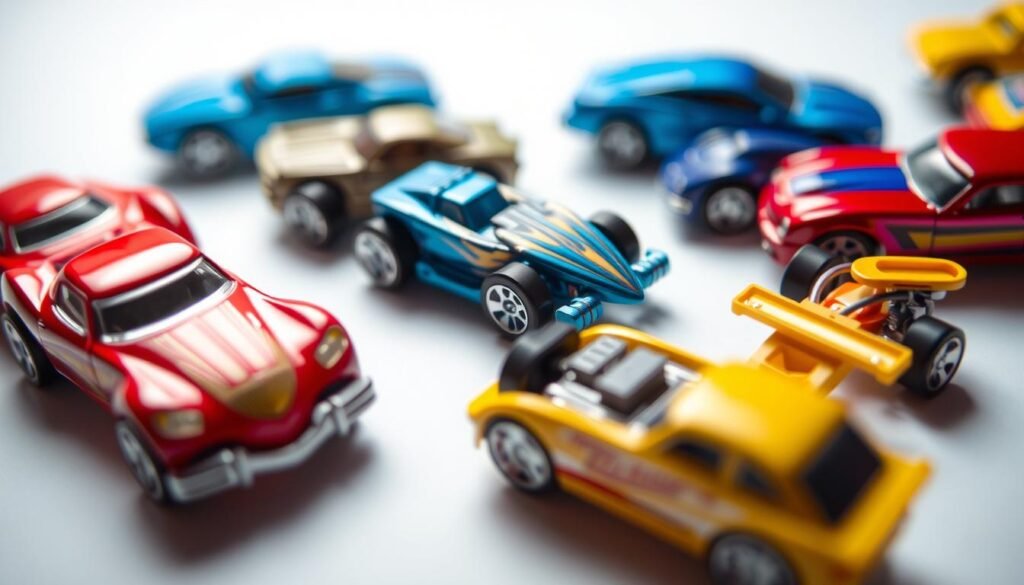
The world of diecast cars is filled with famous brands. Each brand has its own way of making these small wonders. From Hot Wheels’ fast designs to Tomica’s detailed models, let’s see how they use different materials.
Hot Wheels and Their Unique Approach
Hot Wheels has been a favorite since 1968. They are known for their speedy looks and smooth wheels. Made from zinc alloy called Zamac, these cars are detailed and durable.
Hot Wheels also use plastic for more realism and function. This mix makes their cars stand out.
Matchbox: Utilizing Recycled Materials
Matchbox, known since 1953, is famous for its small boxes. Recently, they started using recycled materials. They mix recycled zinc and aluminum into their models.
This shows their commitment to the environment without losing quality or detail.
Tomica: Japanese Craftsmanship
Tomica, a Japanese brand, has been making detailed models since 1970. They use zinc alloy and plastic to create accurate replicas. Tomica’s models show the skill of Japanese manufacturing.
| Brand | Scale | Materials |
|---|---|---|
| Hot Wheels | 1:64 | Zamac (zinc alloy), plastic |
| Matchbox | 1:64 | Recycled zinc, aluminum, plastic |
| Tomica | 1:64 | Zinc alloy, plastic |
Each brand has its own way of making diecast cars. This diversity makes their collections exciting for fans all over the world.
Collecting Diecast Cars
For those who love diecast collecting, the materials used are key. They affect the model’s value and appeal. The metal alloy used impacts the model’s durability and feel.
Collectors look at the material quality closely. They check the detail, casting precision, and finish. High-end models, priced higher, have more detail and are rarer, making them more sought after.
Brands like Hot Wheels, Matchbox, Maisto, and AUTOart cater to different tastes. Hot Wheels has been a leader for over 50 years, offering a variety of models. Matchbox is known for realistic and durable vehicles.
Why Material Matters in Collecting
The materials in diecast cars affect their value and appeal. Cheaper models use zamak, while pricier ones use better materials. These premium models attract collectors who seek exclusivity and rarity.
Assessing Quality Based on Material
When judging a diecast car’s quality, collectors look at several things:
- The precision and detail of the casting
- The durability and weight of the metal alloy
- The quality of the paint and finish
- The presence of any special features or materials
By examining these, collectors can judge a model’s worth. Storing them properly is also key to keep them in good condition. Sunlight, moisture, or extreme temperatures can damage them.
Rarity often drives value in diecast car collecting, making limited-edition models or those with unique features more desirable.
As the hobby grows, knowing about materials is vital. It helps collectors build an impressive collection.
Customization and Modifications
Many diecast fans love to go beyond just collecting. They enjoy customizing and modifying their cars. This hobby lets them make one-of-a-kind models that show off their creativity and skills. It’s a fun journey for both new and experienced collectors.
Materials for Custom Projects
Choosing the right materials is key for any customization project. You’ll need various tools and supplies. Here are some essentials:
- Spray paint for changing the car’s color
- Clear tape and superglue for attaching custom elements
- Black permanent markers for adding details
- Rotary tools, sandpaper, and hobby knives for disassembly and paint removal
- JB Kwik epoxy or tiny #2-56 model screws for reassembly
The process starts with taking apart the diecast car. Then, you remove the old paint and add new paint and custom parts. Finally, you put it all back together. It’s a detailed process that requires patience and precision.
Examples of Popular Customizable Brands
Some brands are better for customization than others. Here are a few top picks:
- Tomy Takara: Known for their high-quality, detailed models that offer a great base for modifications.
- Matchbox: With a wide range of affordable models, Matchbox cars are popular among customizers looking to experiment with new techniques.
You can add weight, swap wheels, change the paint job, or even create custom decals. For example, you can use a printer like the iColor 560. It’s designed for printing on t-shirts and cups but works great for diecast decals too.
Customizing diecast cars is a fun challenge that requires time and a few tools, but the results are worth it. Seeing your vision come to life is an incredible feeling.
Whether you’re a pro or just starting, diecast customization offers endless possibilities. You can create unique, personalized models that show off your style and creativity.
Care and Maintenance of Diecast Cars
As a diecast model collector, I know how important care and maintenance are. Diecast cars can get dusty and dirty, which can harm their look and value. Using the right cleaning methods and storage can keep our collections looking great for years.
Cleaning Techniques for Diecast Models
When cleaning diecast models, we must be gentle. Soft brushes, like makeup brushes or toothbrushes with soft bristles, are best for dusting. For tougher dirt, a mild soap solution works well, but avoid harsh chemicals.
How often you clean depends on where and how you display your models. Models in a dust-free case might need cleaning every 3-6 months. But if they’re in a dusty area or handled a lot, clean them every 1-3 months. Always clean gently and avoid taking apart the model to prevent damage.
Storage Solutions to Prevent Damage
Storing diecast models right is key to keeping them in good shape. Store them in a cool, dry place, away from sunlight and heat. This prevents fading and warping. Display cases, shelves, and protective packaging are good choices.
Think about the protection each storage option offers. Acrylic cases keep dust out while letting you see the models. Padded boxes or compartments protect against scratches and bumps. Stores like Auto World Store have many supplies, including vehicles and kits, for collectors.
| Cleaning Frequency | Environment |
|---|---|
| Every 3-6 months | Dust-free display case |
| Every 1-3 months | Exposed to dust or frequent handling |
Maintaining diecast models in impeccable condition can impress other collectors, potentially increasing their value and desirability.
By taking good care of diecast models and storing them properly, collectors can keep their collections in top shape. This preserves their value and lets us enjoy them for many years.
Diecast Models in Pop Culture
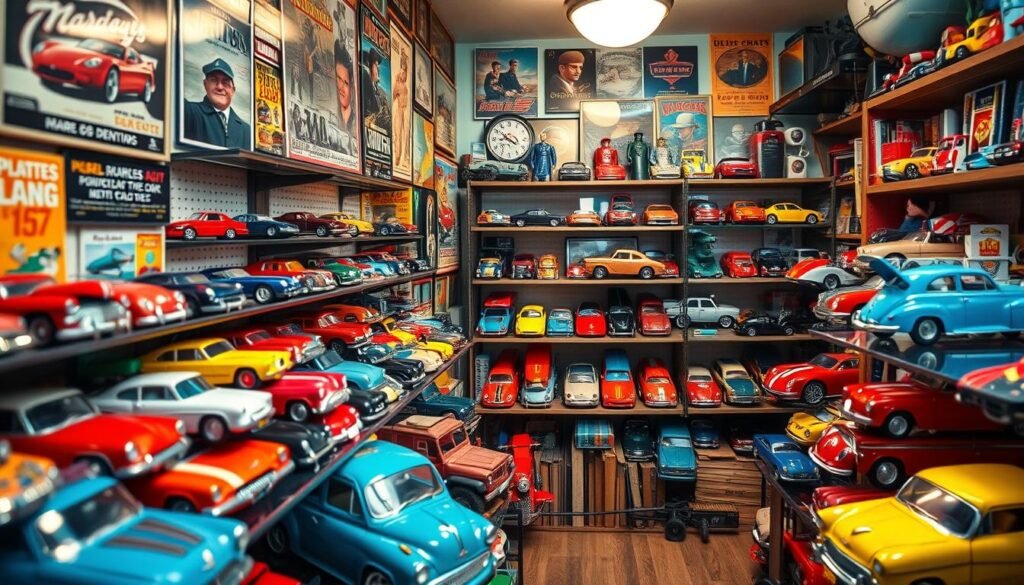
Diecast cars have been a big part of pop culture for decades. They have captured the hearts of many. These small models have become more than toys; they are treasured by collectors all over the world.
The Influence of Diecast Cars in Movies
Diecast models have made a big impact in movies. Iconic vehicles from films have been turned into diecast models. This lets fans own a piece of movie history. From James Bond’s Aston Martin DB5 to the DeLorean from “Back to the Future,” diecast in movies has become a big deal.
Diecast Cars and Their Role in Toy Collecting
Diecast toy collecting has become a favorite hobby for many. These small wonders have won the hearts of collectors. The joy of finding rare models and showing them off is what makes collecting so special.
The diecast collecting community is growing fast. There are clubs, events, and online groups for fans. Collectors meet to share their love, trade models, and talk about new releases. This shows how much people love these small cars.
“Collecting diecast cars is more than just a hobby; it’s a way to preserve automotive history and celebrate the artistry of these incredible replicas.” – John Smith, Diecast Collector
As diecast models keep getting better, their place in pop culture will only grow. Whether on a shelf or in a movie, diecast models will keep winning hearts. They will continue to inspire and delight fans for years to come.
Conclusion: The Future of Diecast Materials
The global diecast cars market is growing fast, expected to hit $7 billion by 2030. It’s growing at a rate of 9.2% from 2024 to 2031. This growth means manufacturers are looking into new ways to make diecast cars.
They’re using advanced technologies like 3D printing and computer-aided design (CAD). These tools help make production more precise and efficient. They also allow for detailed designs that were hard to make before.
Innovations in Diecast Production
The diecast cars market uses different materials, like plastic and metal. Metal models, especially from AUTOart, make up 15% of the market. Companies are trying out new alloys and materials to improve their models.
They’re also working on better painting and detailing. This makes the diecast cars look more real and appealing.
Trends in Sustainable Diecast Manufacturing
More people want eco-friendly products, and diecast cars are no exception. Manufacturers are using recycled materials to cut down on waste. They’re also looking into renewable energy and eco-friendly packaging.
As demand for green products grows, companies that focus on sustainability will stand out. They’ll likely do better in the market.
The future of diecast materials is bright, with new ideas and a focus on being green. Collectors will see more high-quality, eco-friendly diecast cars. Companies like Maisto, BBurago, and GreenLight Collectibles are leading the way. The diecast cars industry is set for exciting changes.
FAQ
What are the most common materials used in diecast cars?
What is the die-casting process, and how does it work?
What are the benefits of using diecast materials in model cars?
Can diecast cars be recycled?
What are some popular brands known for their diecast cars?
How should I clean and maintain my diecast car collection?
Source Links
- How Diecast Models Are Made | ModelSpace – DeAgostini Blog – https://blog.deagostini.com/2020/11/how-diecast-models-are-made-modelspace/
- How are diecast models made? – https://minimodelshop.com/blog/mini-models-how-are-diecast-models-made?srsltid=AfmBOop4PnwNBDHzoIISa624BDqUDETKkj_gAQBjoSKwjk8jKvMKrvRO
- Die-cast toy – https://en.wikipedia.org/wiki/Die-cast_toy
- Introduction to Diecast Model Cars – Five Diecast – https://fivediecast.com/introduction-to-diecast-model-cars/
- DieCast 101 an introduction to Die-Cast – http://die-cast.com/
- 7 Key Knowledge about Diecast Car Brands – https://tonysourcing.com/diecast-car-brands/
- The Manufacturing Process: How Are Diecast Model Cars Made? – https://livecarmodel.com/blog/the-manufacturing-process-how-are-diecast-model-cars-made/?srsltid=AfmBOoqyI9oQavMKRdKj11xNVRsA38oFWl-nTykG9KFfdauTvPP47i5h
- Die Casting Overview: Process, Materials | Xometry Pro – https://xometry.pro/en/articles/die-casting-overview/
- The Manufacturing Process: How Are Diecast Model Cars Made? – https://livecarmodel.com/blog/the-manufacturing-process-how-are-diecast-model-cars-made/?srsltid=AfmBOopuM8_zdRSDYDn0jmqCj2ynC2OhKdZj2hj6DhMc0NOhNEuG6-tH
- How are diecast models made? – https://minimodelshop.com/blog/mini-models-how-are-diecast-models-made?srsltid=AfmBOoo-vrnnLph0KUE5VSAlmfX8xbx81v8yA57k27OD5wJbsMwAaZRR
- Automotive Die Casting Overview: Benefits, Materials, and Trend – APW – https://autoprotoway.com/automotive-die-casting-overview/
- Die Casting Automotive Parts: Applications and advantages – https://www.zetwerk.com/resources/knowledge-base/die-casting/examples-and-advantages-of-die-casting-automotive-parts-production/
- Hot Wheels — Design Life-Cycle – http://www.designlife-cycle.com/hot-wheels-life-cycle
- Matchbox cars get green makeover in eco drive – https://www.bbc.com/news/business-56728387
- List of model car brands – https://en.wikipedia.org/wiki/List_of_model_car_brands
- Which brand of diecast model cars is better? How to judge the quality of diecast model cars? – https://www.paudimodel.com/which-brand-of-diecast-model-cars-is-better/
- Diecast Car Collecting Guide — The Pristine Auction Blog – https://blog.pristineauction.com/blog/nascar-diecast-cars-exploring-their-allure-value-and-signed-collectibles
- Common Mistakes to Avoid in Diecast Car Collecting – Darlington Diecast – https://www.darlingtondiecast.co.uk/2023/11/13/common-mistakes-to-avoid-in-diecast-car-collecting/?srsltid=AfmBOoqSPW4EhLDVoY–CNgFPcrEEQzJSp6l6MtafFAyHwjr7qoU5v0g
- Affordable vs High-End Diecast Collectibles – What you need to know | MYDIECASTCARS – https://www.mydiecastcars.com/difference-between-affordable-vs-high-end-diecast-cars/?srsltid=AfmBOorsvm7W5wwvPr2pry9bg_P6-Ns62H76mMqQb4gA_0ICznTpdYUz
- How to Modify a Die-Cast Car – https://www.instructables.com/How-to-Modify-a-Die-Cast-Car/
- Beginner’s guide to modifying cars – https://www.redlinederby.com/topic/beginners-guide-to-modifying-cars/3311
- A Guide to Master Diecast Car Customization – https://lasertransfersupplies.com/blogs/articles/guide-to-master-diecast-car-customization
- How to Clean & Preserve Diecast Scale Models – https://www.autoworldstore.com/blogs/tips-tricks/cleaning-diecast-models?srsltid=AfmBOoovBtpkMpAKOBpeW_fD4Pa-2G4Mfp6le6zResoykbbrGpUPK3Vm
- The Ultimate Guide to Cleaning Your Diecast Scale Model Collection – https://www.weissbrothers.us/the-ultimate-guide-to-cleaning-your-diecast-scale-model-collection/?srsltid=AfmBOop-8HBIenXbMizzvwB3zGsyZUSrf21h8tTmU5M1qMbtZor-aoEl
- Vintage Diecast Cars: A Nostalgic Journey Through Time – https://www.mydiecastcars.com/vintage-diecast-cars/?srsltid=AfmBOorWWU6Ylxidb5__IFRYi8HjK15PTWT5_-ciDufLuIQSTj-phg1y
- A Look Back at the Fascinating History of Model Cars – https://modelcars.com/blogs/news/a-look-back-at-the-fascinating-history-of-model-cars?srsltid=AfmBOor9qMUD8DVmHF0847IS_i9vxBlp6moGqYRraf93U6jhZw0pdA2_
- 2024 Hot Wheels Pop Culture Diecast Model Cars 5pc Set Premium Series | eBay – https://www.ebay.com/itm/326192394064
- The Global Market for Automotive Diecast Scale Models, Forecast to 2030 – Nostalgia Driving Demand for Classic Car Replicas, Market to Reach $7 Billion – https://www.globenewswire.com/news-release/2024/09/11/2944602/0/en/The-Global-Market-for-Automotive-Diecast-Scale-Models-Forecast-to-2030-Nostalgia-Driving-Demand-for-Classic-Car-Replicas-Market-to-Reach-7-Billion.html
- Diecast Model Car Market : Exploring Future Growth Developments By 2031 | [113 Pages] – https://www.linkedin.com/pulse/diecast-model-car-market-exploring-future-growth-hmi5e
- Charting the Future: Comprehensive Analysis of the Global Diecast Cars Market (2024 – 2031) – https://www.linkedin.com/pulse/charting-future-comprehensive-analysis-global-diecast-cars-nl0de

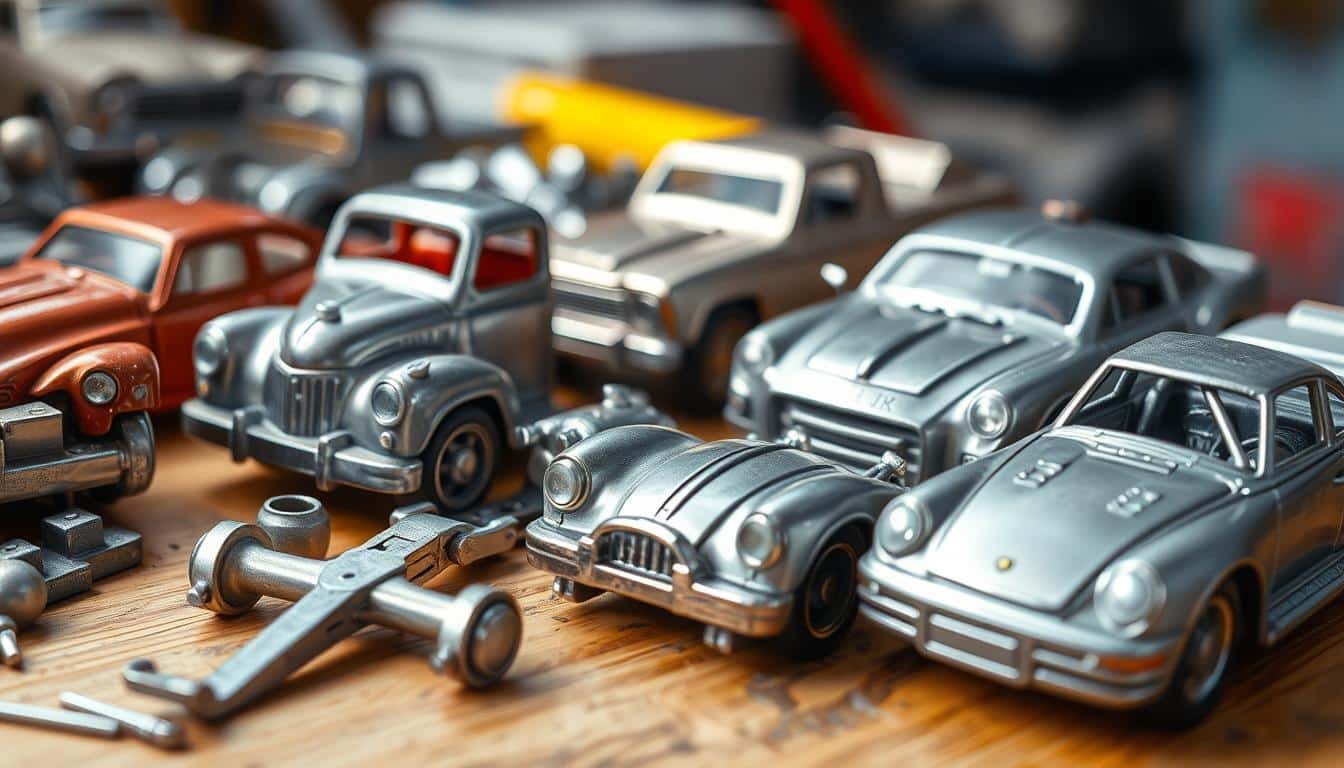

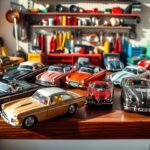
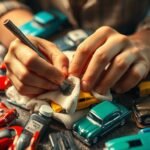



Interesting read! But arent diecast cars also made from plastic parts? I thought they werent solely metal.
Interesting read, but what about the environmental impact of making diecast cars? Is there a sustainable alternative?
Interesting read but what about plastic components? Arent they also integral? Feels like youre just glorifying metal here.
Interesting read. Do we know how the manufacturing process of diecast cars impacts the environment?